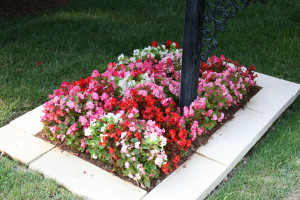 Because shrubs and bushes are an essential part of forming the structure and background of your garden, it is imperative to keep them looking great. Even though the exact specifics of caring for each variety of bush or shrub vary, based on its type, these general guidelines can help you easily keep your landscaping in tip-top shape.
Because shrubs and bushes are an essential part of forming the structure and background of your garden, it is imperative to keep them looking great. Even though the exact specifics of caring for each variety of bush or shrub vary, based on its type, these general guidelines can help you easily keep your landscaping in tip-top shape.
An Effective Watering Plan
The basic watering needs for your shrubs and bushes will depend on the site and environmental climactic conditions. Many plants need at least an inch or so of watering each week. To ensure each plant is receiving enough rainfall, you can use an empty cat food can or tuna can to see how high it gets filled. Should the rainfall results not be adequate, you can supplement your watering plan using a hose or sprinkler system.
A deep watering once or twice each week is much more preferable over nightly shallow watering, which can discourage deeper root growth. When shrubs and bushes do not have deep roots, they are prone to harm during times of drought. In more sandy soil areas, or when the planting environment is extremely hot, your botanicals will require a more frequent watering schedule. Additionally, during the first year of any plant life in your garden, or landscape, any additional watering can help the roots become well-established in its new growing environment.
Fertilizing Your Bushes and Shrubs
It is important to understand exactly what types of plants, shrubs and bushes are planted in your garden or landscape area. While fertilizing is essential for some varieties of shrubs and bushes, which benefit immensely from the nourishment, others simply do not need it. The variety of plants that enjoy acidic soil including blueberries, hollies and rhododendrons will produce better flowers with the addition of highly acidic amendments. Others, including lilacs, greatly enjoy more alkaline amendments.
Adding fertilizer during early spring along with adding a top dressing of quality compost will provide exceptional benefits to nearly all types of shrubs and bushes. As an alternative, you can use an all-purpose, balanced fertilizer instead. Continually blooming shrubs, including roses, will produce better blooms if you feed them their fertilizer once the growing season is near its end.
Pruning and Deadheading
Most types of rose shrubs have a better appearance when aggressively pruned. Others, including lilacs and a variety of hydrangeas, are best left alone. Many bushes and shrubs do better when pruned during the early spring months, while others thrive with pruning after they have already presented their flowers.
Pest and Disease Control
It is imperative to regularly check for any evidence of disease and pests, which should include deformed growth, discoloration or damage to the foliage. Lift the leaves up to check the underside, and use insecticidal soap or hot pepper wax as an all-purpose pest repellent. Additionally, you can take a sample of the pests or a remnant of the plant to your local nursery for advice on how to treat the damaged plant.
Learning how to care for shrubs and bushes can enhance the beauty and health of your garden. With minimal dedication to your landscape you can keep your garden and lawn looking its best.
